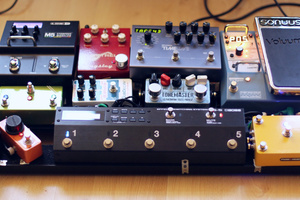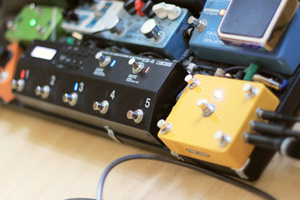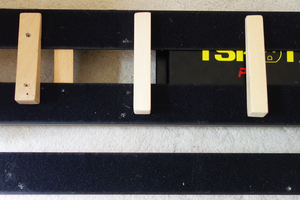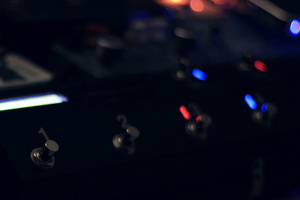
 Sascha
SaschaBoss ES-5 Effects Switching System – Intro
The Boss ES-5 loop switcher has been the switching central of my pedal board since autumn 2017. I did a lot of experimenting and learning with it, which I’ll share here and in the following articles: Boss ES-5 Tips I: Building your Pedal Board, Boss ES-5 Tips II: Setting up your ES-5 and Boss ES-5 Tips III: Building Patches.
Let’s get started with an introduction video to my ES-5 based current pedal board:
Table of Contents
Why a Loop Switcher?
When you are using effect pedals, especially on stage, you may find yourself stepdancing while trying to switch on/off multiple pedals between songs, or even between sections of one song. The main reason why many guitar players (and other musicians) get a loop swicher is to simplify this – by switching multiple pedals at once.
Other reasons for getting a loop switcher may include that you want to keep currently unused effect pedals out of your signal chain. Or that you want to swap the order of pedals for certain sounds. However, a loop switcher normally will not directly contribute to your sound, so you should think twice if you really need one, and how large (how many loops) it needs to be.
What makes the ES-5 special?
When the ES-5 was released in Januar 2016, there was no direct competition (meanwhile, there is); same was true for the ES-8 that arrived one year earlier. Features of the ES-5 include:
- It’s fully programmable. That is, you have 200 presets (called Patches). In each of them, you can store which of the 5 loops is currently on/off; and a lot more. You can recall Patches via MIDI. There’s also a display that can show the current Patch name, or other relevant information. But none of this is new, Bob Bradshaw already built programmable loop switchers in the 1980s ...
- The ES-5 has a nice and pedal board friendly format: 33,7 × 9,7 × 6,8 centimeters (including jacks and switches), all jacks on the north side, 1,3 kg weight, runs on standard 9V center negative power. And, in addition to the loops, there’s two TRS dual switching control outputs; and, more important, you can send MIDI commands to other devices. But again, not really new – the Disaster Area DPC-5 could do most of this already in 2012 – okay, no display, only one TRS out, less MIDI functions; but still five programmable loops and MIDI at an even smaller size.
- It is based on an analog switching matrix that allows freely changing the loop order. Yes, SoundSculpture Switchblade products could do this already around 2013; but their stuff was quite expensive, and they never came up with a pedal board friendly unit with integrated footswitches. The Decibel Eleven Pedal Palette was pedal board friendly, but had only 4 loops, and only limited ways to re-order them. AFAIK Boss were the first to offer a pedal with fully flexible routing when they premiered the ES-8 in January 2015. One year later, at the time when Boss presented the smaller ES-5 at the NAMM, Gigrig published a software update allowing their G2 loop switcher to also re-order the signal chain. Still, the G2 was quite a bit larger and a lot more expensive than the ES-5.
- The ES-5 also can do parallel loop chains and has a variable gain control that can go from -12 dB to +6 dB in 3 dB steps. This is normally located right before the output, but when using parallel loops or spillover functionality, the gain circuit (called “mixer” by boss) is moved there. G2 offers much more gain control options (pre and post gain per loop), but then again: Larger, more expensive.
Is the ES-5 True Bypass?
No, it’s not. True bypass means that if a loop is switched off, the signal just runs through wire, not through any additional circuitry. The analog switching matrix that the ES-5 uses is not true bypass in this strict sense of the word. Still, it has extremely little influence on the sound, and it is fully analog (unlike the Boss MS-3 which always digitizes the full signal). On my pedal board, I have the ES-5 with all its loops sitting in an external true bypass master loop; so I can A/B the sound of the ES-5 (with all loops and buffers bypassed) vs. a full true bypass. I can hardly hear any difference, and my ears are not too shabby.
There’s people who claim that their G2 sounds much better than an ES-5/-8. There’s also people who say that both have almost zero negative impact on the signal. I have no idea if what Gigrig calls their “Passive True Bypass Matrix” is actually true bypass, or also just a glorified analog switching matrix. I suspect the latter. However, the G2 is a great product, too. I will still go with my ES-5, since it’s smaller, has better MIDI control, and also: I want a text display with preset names.
What else is there on the market?
The ES-8, the Gigrig G2/G3 and the Soundsculpture products require more money and pedal board real estate. Of course, there’s lots of other great loop switchers: Small ones like the Morningstar ML5 and big ones like the EHX Super Switcher and all kind of stuff in between. But me, I’m only interested in loopers that can change the order of loops, and preferrably also allow parallel loops. I love being able to do stuff like:
- putting my analog phaser in front of my dirt pedals for more univibe-ish sounds on some patches, and behind the dirt pedals for more 1970s phaser-ish sounds;
- record all kind of pedals into the looper of my Strymon Timeline, and then run the recorded loop through some of those pedals again;
- creating strange ambient sounds by putting delay or reverb before the dirt pedals on a few patches;
- freely using the multifunctional M5 before or after other pedals, whereever it fits best in a certain sound; or even
- add an analog dry path to the M5 (that doesn’t have one by design), by running it in parallel to an empty path on the ES-5.
This narrows down the current direct competitors to these three products:
- There’s the Musicom Lab EFX LE mk. II (and is precedessor Musicom Lab EFX LE). This was clearly designed as a direct competition for the ES-5 (you might even call it a rip-off ... but one that improves on the original), such as their larger EFX MK V channels the ES-8. The EFX LE mk. II is only slightly higher in price than the ES-5. At a slightly smaller size (only 32 cm width), it offers 7 loops instead of the ES-5’s 5, two of them even in stereo, while the ES-5 is fully mono. Just ordered one, can’t wait to A/B it against the ES-5 ... seems like MIDI functionality and assigning footswitches is a bit more advanced on the ES-5, and some people claim Musicom Lab build quality is not on Boss level. I can’t tell (yet).
Shortcomings compared to the ES-5 include: It has only one instead of two TRS dual switching outputs; and it cannot do fancy MIDI stuff like LFOs (“WAV” in Boss terminology) and ramping (“INT”).
As an advantage, it comes with an isolated audio output for fixing ground loop hum that occurs in some dual amp setups – which of course is not needed on the ES-5, which only has one audio output anyhow.
Improvements of EFX LE mk. II compared to mk. I include the option to couple two mono loops to a stereo loop, and running on standard DC 9V power (mk. I required 12V). - There’s the Mastermind PBC/6X; it comes with a different form factor (less width, more depth than the ES-5; overall 13% smaller and 30% lighter), and offers interesting functionality in that small package: There’s 7 loops, 4 of which are stereo, there’s USB, a built-in tuner and advanced MIDI control including sending of MIDI note and SysEx messages (which the ES cannot). Still, this load of features comes at a price: The PBC/6X costs almost twice as much as the ES-5 or EFX LE, at least in Europe. Also, as the only one of the loopswitchers compared here, it lacks parallel paths and gain control options. Compared to the ES-5, the second TRS switching out is missing; and compared to the EFX LE, isolated audio output is missing.
- The new Gigrig G3 Atom is small and has great features, but also costs quite a lot of money (more than twice as much as an ES-5, as of Dec 2020 in Europe; and still like 10% more than a PBC/6x). With 6 stereo loops, it has more to offer for stereo players than any of the above. However, most players will use less than 6 stereo pedals, so PBC/6X and EFX-LE II with their 7 loops each may have advantages here. Concerning MIDI, the ES-5 is still ahead in many ways: Atom can send 12 MIDI messages per Patch, ES-5 can send 8 PC + 16 CC = 24 messages. No MIDI LFOs and ramping on the G3 either. OTOH, it comes with two analog gain stages with continuous gain control (where the ES-5 has only one, with -12dB to + 6dB in 3 dB steps).
So, both interesting products, but not interesting enough to sell my ES-5 and get one of those. At least not until RJM comes up with a new firmware allowing parallel paths.
Bottom Line: Strengths and Weaknesses
5 years after being introduced to the market, the ES-5 is still a good choice for a comparatively small loop switcher. If you need stereo, you should seriously consider the EFX-LE mk. II as an alternative with similar dimensions in the same price range. If you love advanced MIDI functionality including stuff like ramping parameters or MIDI LFOs, go for the ES-5. If you are rich AF, get the Gigrig Atom instead.
ES-5 strengths include:
- Fully analog audio path; not true bypass, still very transparent (same is true for EFX LE/mk. II, Gigrig G2/G3 and PBC/6x)
- Easy-to-read text display
- 200 presets, MIDI (incl. MIDI clock)
- fully flexible routing of the 5 mono loops, including parallel paths and trails
- programmable analog gain (-12 to +6 dB in 3 dB steps)
- switching of up to 4 external functions via 2 TRS outs
- flexible assigning of footswitches (with limitations)
- connectivity for expression pedal or external dual footswitch
ES-5 weaknesses include:
- Only mono loops (I will cover building a stereo rig around an ES-5 in a future article);
- You can only have expression pedal OR dual external footswitch input;
- Limitations to the manual mode: You have to hold BANK quite long to get into it. Changes you make there are immediately lost once you leave (it would be more logical to keep them until you change to another Patch); also, you can hardly configure footswitches in that mode;
- Limitations to the analog gain: cannot be placed freely in the signal chain (like, you can’t use it to affect just one out of two parallel paths), cannot be changed through footswitches nor MIDI within one preset, doesn’t go down to silence, 3 dB are rather big steps;
- Both for toggling between two different MIDI program change commands, and for toggling between ramping one MIDI parameter up and down, you need to assign two footswitches (rather than just one);
- 8 Assigns is often not enough (an Assign defines a function triggered by an event; like, “hit the BANK footswitch for Tap Tempo”)
- No USB (meaning, you have to partly dismantle you pedal board to connect the ES-5 to a computer running the ES-5 editor software using 5-pin MIDI)
In the upcoming articles, I will explore the ES-5 in more detail and offer some advice and tips for users. First, here’s an article about building an ES-5 based pedal board.



Comments